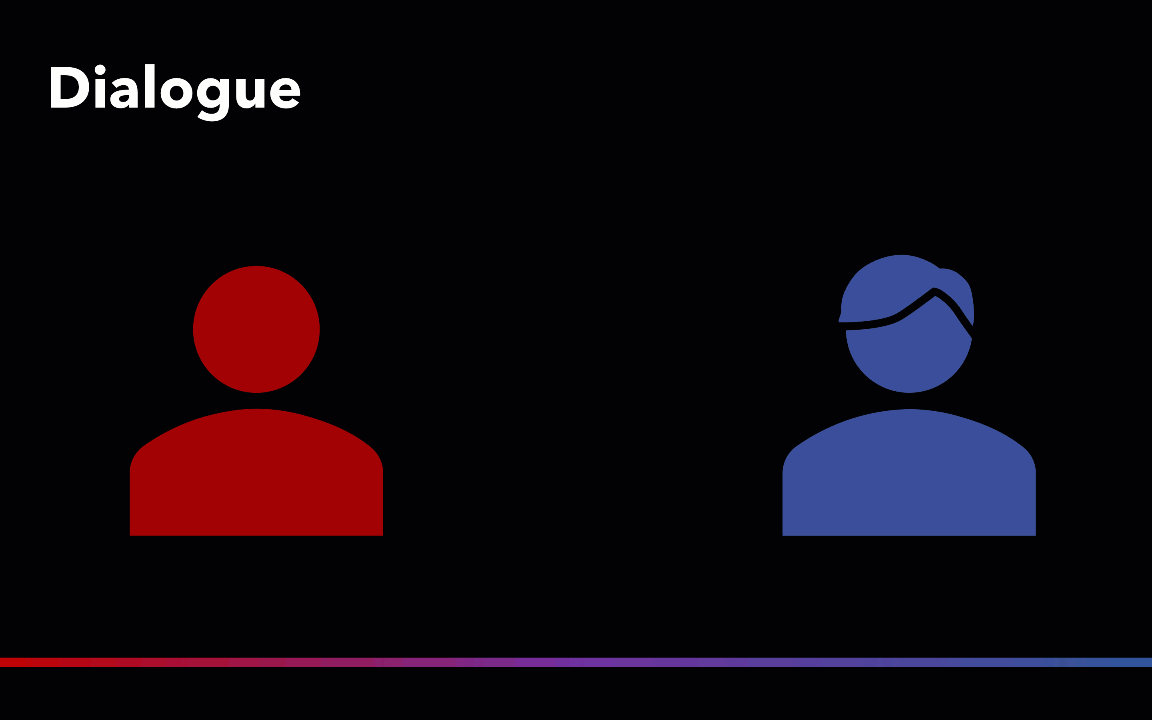Dialogic Skills: Debate vs Dialogue
Most of the time when we enter into a conversation about a difficult topic we end up in a Debate. We stake out a position and defend it. We end up talking at each other instead of talking together. Statements bounce of each of the participants. There’s a saying, “People don’t listen, they reload.” How many times are you thinking of a rebuttal while the other person is speaking instead of really listening to them?
Debate is a zero-sum game and guarantees that, in things like politics, at least half of the people’s voices will be ignored. It is impossible for a society to thrive when this is the case.
A more productive way to communicate is through Dialogue. What makes dialogue effective is that it creates an environment where people can say what they need to say while being assured that others are able and willing to listen. Dialogue is not a zero-sum game like debate. It is generative with the result that new solutions can be created that neither party would have thought of on their own. Unlike in debate where both parties end up unchanged, in dialogue each party is changed by the other.
Dialogue is a dialectic between what is going on inside us and what we think is going on inside others. During dialogue we must not only make space for ourselves, but we need to make space for others with curiosity, generosity, and compassion.
Dialogic Practices: Inquiry vs Advocacy
Dialogue has a different cadence and tone than debate. Missing in true dialogue are the verbal volleys, like siege engines, traded back and forth with the goal of knocking down the defenses of the opposing side and advocating one’s own position. In dialogue, there are no sides. No participant has a privileged position over the others. It is a safe, generative space where entirely new viewpoints are created by participants thinking together rather than in opposition. A dialogic space is one of inquiry rather than advocacy. To accomplish this, participants must master certain skills that make dialogue possible. We break dialogic skills into two areas. Making Space for the Self and Making Space or Others.
Make Space for the Self
We exist within tightly defined boundaries which comfort us like a cocoon. Our view of reality serves less to describe objective reality and more to serve our own psychological needs. In order to learn and grow we must make room within ourselves to explore alternate views and the unknown.
-
Critically explore your own views and emotions. Use SCARF and Identity to help frame the sources of your own viewpoints. What stories come to mind when you think about how you developed your own viewpoints? Why do you cling to them so tightly? What are you afraid of losing by exploring new viewpoints?
-
Are you saying what others expect from you or are you saying what is coming up for you? What emotions are attached to what you are saying. If you feel you cannot say what you need to say why not?
-
Mind and Body influence each other. Our Body gives clues as to what’s happening in the mind and can also influence it. Explore how your body responds to stressful situations and how it in turn can influence how we feel mentally.
Make Space for Others
We tend to stick with people who think like we do and ignore or denigrate those who do not. But other people are sources of new ways to think about things. They represent that which we do not understand so to broaden our own viewpoints, we need to make space for those of others. But first to do that, we need to better understand ourselves.
-
Other people have different viewpoints for a reason. We do not need to agree with those viewpoints but should accept that they are valid given the experiences and relationships influencing the other person especially considering the shared neurological underpinnings of those viewpoints.
-
Genuinely listen with curiosity and generosity. When are you typically willing to listen to other opinions and when are you not? Do you feel like the world should have more or less structure and rules and how does that affect your willingness and ability to listen? Listen with body and mind. Actively seek to know more about the other point of view. Instead of thinking how to rebut what they are saying ask, “How might they be right?”
-
What you hear and see may disgust you, but pausing your reaction may enable further understanding. Much of our reactions are automatic, but take notice of them and then put them aside. Framing them in terms of S.C.A.R.F. and Identity both yours and others’ will help to open up space for them within yourself.
Even with dialogic skills straightforward dialogue may be too difficult because:
We either do not engage initially or have too much difficulty opening up because we are too triggered from the start.
There is a lack of clarity about the sources of our own and other’s viewpoints.
We often have no common language to express our viewpoints.
There is little to no empathy for the other side.
We assume the differences between sides are too great to bridge so do not bother engage in the first place.
We have too steep a climb to get to a generative space.
The Solution: Brain-based Holistic Dialogue
Our brain-based approach to dialogue:
Brings clarity about the source of our viewpoints and behaviors.
Develops a common language in which to speak our truth
Develops empathy by establishing commonalities at the most basic human level.
Identifies unexpected commonalities before dialogue takes place.



